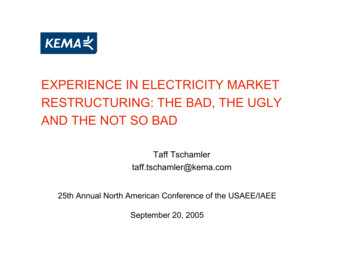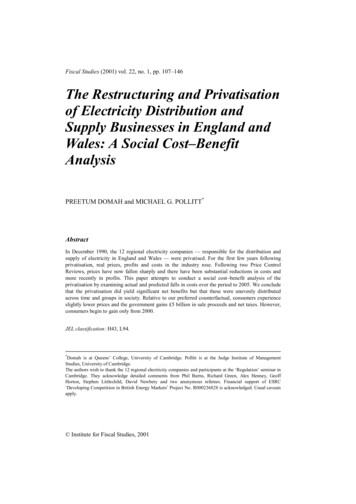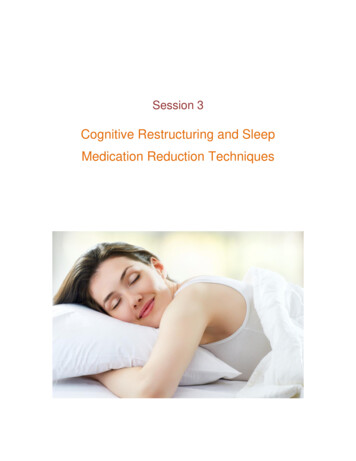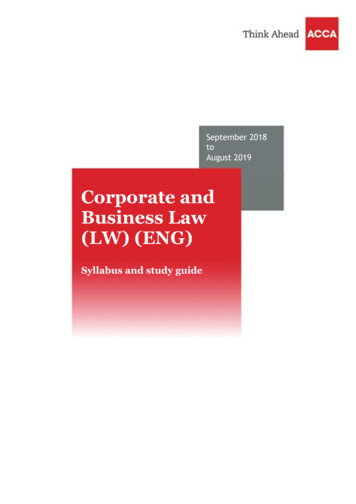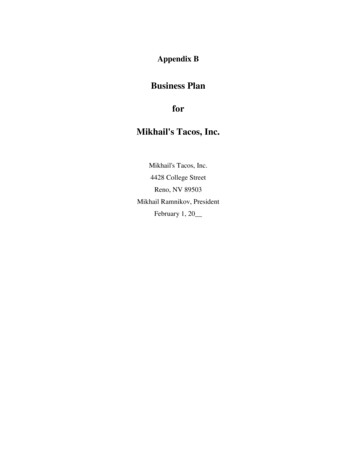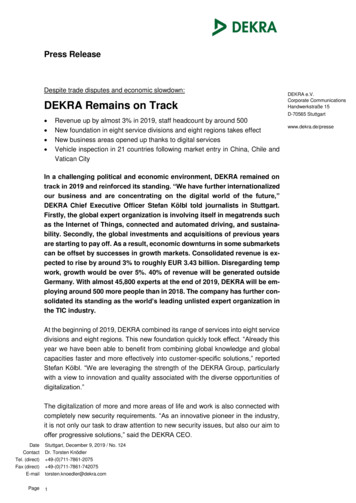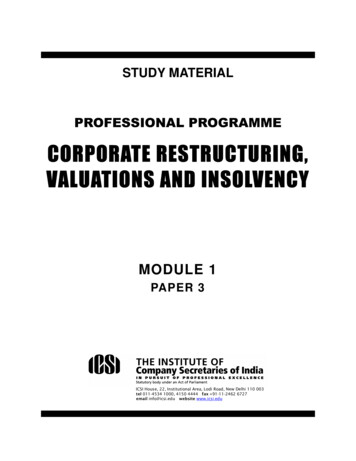
Transcription
STUDY MATERIALPROFESSIONAL PROGRAMMECORPORATE RESTRUCTURING,VALUATIONS AND INSOLVENCYMODULE 1PAPER 3ICSI House, 22, Institutional Area, Lodi Road, New Delhi 110 003tel 011-4534 1000, 4150 4444 fax 91-11-2462 6727email info@icsi.edu website www.icsi.edu
THE INSTITUTE OF COMPANY SECRETARIES OF INDIATIMING OF HEADQUARTERSMonday to FridayOffice Timings – 9.00 A.M. to 5.30 P.M.Public Dealing TimingsWithout financial transactions – 9.30 A.M. to 5.00 P.M.With financial transactions – 9.30 A.M. to 4.00 w.icsi.eduE-mailinfo@icsi.eduLaser Typesetting by Delhi Computer Services, Dwarka, New DelhiPrinted at Tan Prints/PRN-2441/2000/July, 2014
(iii)PROFESSIONAL PROGRAMMECORPORATE RESTRUCTURING, VALUATION AND INSOLVENCYCorporate Restructuring is a non-recurring exercise for an organisation but it has a lasting impacton the business and other concerned agencies due to its numerous considerations and immenseadvantages viz., improved corporate performance, better corporate governance etc. The regulatoryprovisions and the multitude of judicial and unresolved issues enunciate that the professionals dealingwith restructuring should possess unequivocal and explicit knowledge of the objective approach andperspective of the subject.The purpose of this study material is to provide an in-depth understanding of all aspects andintricacies of law and practical issues affecting and arising out of Corporate Restructuring, Valuationas well as Insolvency, aims at through each phase of preparation, stressing upon and dealing,exhaustively with key concepts, legislative aspects and procedures, duly annotated with judicialreferences.Company Secretaryship being a professional course, the examination standards are set very high,with emphasis on knowledge of concepts, applications, procedures and case laws, for which solereliance on the contents of this study material may not be enough. Besides, as per the CompanySecretaries Regulations, 1982, students are expected to be conversant with the amendments to thelaws made upto six months preceding the date of examination. The material may, therefore, beregarded as the basic material and must be read along with the original Bare Acts, Rules, Regulations,Case Law, Student Company Secretary bulletin published and supplied to the students by the Instituteas well as recommended readings.The subject of Corporate Restructuring, Valuation and Insolvency is inherently technical and issubjected to constant refinement through new legislations, rules and regulations made there under,court decisions on specific legal issues and corporate business dynamics. It, therefore, becomesnecessary for every student to constantly update himself with the various legislative changes made aswell as judicial pronouncements rendered from time to time by referring to the Institute’s journal‘Chartered Secretary’ and bulletin ‘Student Company Secretary’ as well as other law/professionaljournals like Company Law Journal, Corporate Law Advisor, SEBI and Corporate Laws, CompanyCases etc.His Study Material is based on the Companies Act, 1956 except for the provisions relating to BuyBack of Shares which are notified upto June 30, 2014 under Companies Act, 2013. However, it mayso happen that some developments might have taken place during the printing of the study materialand its supply to the students.The students are therefore, advised to refer to the Student Company Secretary and otherpublications for updation of the study material.In the event of any doubt, students may write to the Directorate of Academic in the Institute forclarification at academics@icsi.edu.Although care has been taken in publishing this study material, yet the possibility of errors,omissions and/or discrepancies cannot be ruled out. This publication is released with anunderstanding that the Institute shall not be responsible for any errors, omissions and/or discrepanciesor any action taken in that behalf.Should there be any discrepancy, error or omission noted in the study material, the Institute shallbe obliged if the same are brought to its notice for issue of corrigendum in the Student CompanySecretary.
(iv)PROFESSIONAL PROGRAMMESYLLABUSFORMODULE I - PAPER 3: CORPORATE RESTRUCTURING, VALUATION ANDINSOLVENCYLevel of Knowledge: Advance KnowledgeObjective: To acquire knowledge of the legal, procedural and practical aspects of CorporateRestructuring, Valuation and Insolvency.Detailed Contents:PART A - Corporate Restructuring (50 Marks)1. Introduction and Concepts Meaning of Corporate Restructuring Need, Scope and Modes of Restructuring Historical Background Emerging Trends Planning, Formulation and Execution of Various Corporate Restructuring Strategies - Mergers,Acquisitions, Takeovers, Disinvestments and Strategic Alliances, Demerger and Hiving off Expanding Role of Professionals2. Merger and Amalgamation Introduction Legal, Procedural, Economic, Accounting, Taxation and Financial Aspects of Mergers andAmalgamations including Stamp Duty and Allied Matters Interest of Small Investors Merger Aspects under Competition Law Jurisdiction of Courts; Filing of Various Forms Amalgamation of Banking Companies and Government Companies Cross Border Acquisition and Merger3. Corporate Demerger and Reverse Merger Concept of Demerger; Modes of Demerger - by Agreement, under Scheme of Arrangement Demerger and Voluntary Winding Up Legal and Procedural Aspects; Tax Aspects and Reliefs Reverse Mergers – Procedural Aspects and Tax Implications4. Takeover Meaning and Concept Types of Takeovers; Legal Aspects – SEBI Takeover Regulations
(v) Disclosure and Open Offer Requirements Bail Out Takeovers and Takeover of Sick Units Takeover Defences Cross Border Takeovers5. Funding of Merger and Takeover Financial Alternatives; Merits and Demerits Funding through various Types of Financial Instruments including Equity and Preference Shares,Debentures, Securities with Differential Rights, Swaps, Stock Options; ECBs, Funding throughFinancial Institutions and Banks Rehabilitation Finance Management Buyouts/Leveraged Buyouts6. Financial Restructuring Reduction of Capital Reorganization of Share Capital Buy-Back of Shares – Concept and Necessity Procedure for Buy-Back of Shares by Listed and Unlisted Companies7. Post Merger Reorganization Factors involved in Post Merger Reorganization Integration of Businesses and Operations Assessing Accomplishment of Post Merger Objectives; Measuring Post Merger Efficiency8. Case StudiesPART B – Valuation (30 Marks)9. Introduction Meaning, Objective & Scope of Valuation Principles of Valuation Preliminary Work relating to Valuation Valuation Standards and Valuation Analysis10. Valuation Techniques Historical Earnings Valuation Asset Based Valuation Market Based Valuation11. Regulatory and Taxation Aspects Legal & Regulatory aspects related to Valuation such as SEBI Regulations/ RBI Regulations Income Tax Implications12. Valuations for Different Strategies Merger & Acquisition, Demerger, Slump Sale Liquidation and Corporate Insolvency
(vi) Internal & External Restructuring Valuation of Intangibles Valuation of SecuritiesPART C – Insolvency (20 Marks)13. Introduction Concept of Insolvency, Historical Developments History of Bankruptcy Laws in USA, UK and India14. Revival, Rehabilitation and Restructuring of Sick Companies Sick Companies and their Revival with Special Reference to the Law and Procedure relating toSick Companies15. Securitization and Debt Recovery Overview of the Securitization and Reconstruction of Financial Assets and Enforcement ofSecurity Interest Act, 2002; Process; Participants Special Purpose Vehicle (SPV), Asset Reconstruction Companies (ARCs), Qualified InstitutionalBuyers (QIB) Overview of the Recovery of Debts Due to Banks and Financial Institutions Act, 1993 Tribunal, Procedure; Compromises and Arrangements with Banks and Creditors16. Winding Up Concept; Modes of Winding Up; Administrative Machinery for Winding Up Winding up Process and Procedure; Managing Stakeholders and Parties in Liquidation;Conducting Meetings of Shareholders/Creditors; Dealing with Contracts; Managing Estate Outsourcing Responsibilities to Professionals/Service providers such as Valuers, SecurityAgencies Best Practices in Performing Liquidation/Administrator Functions; Accountability and Liabilities;Role of Liquidators and Insolvency Practitioners Consequences of Winding Up; Winding Up of Unregistered Companies; Dissolution17. Cross Border Insolvency UNCITRAL Model Law on Cross Border Insolvency UNCITRAL Legislative Guide to Insolvency Law World Bank Principles for Effective Insolvency and Creditor Rights Asian Development Bank Principles of Corporate Rescue and Rehabilitation Bankruptcy under chapter 11 of US Bankruptcy Code
(vii)LIST OF RECOMMENDED BOOKSMODULE IPAPER 3 : CORPORATE RESTRUCTURING, VALUATION AND INSOLVENCYRecommended Readings and References:1.A. Ramaiya:Guide to Companies Act, LexisNexis Butterworths,Wadhwa, Nagpur2.M.C. Bhandari:Guide to Company Law Procedures, LexisNexisButterworths Wadhwa Nagpur3.ICSI:Handbook on Mergers Amalgamations and takeovers.4.K. R. Sampath:Mergers/Amalgamations, Takeovers, Joint Ventures,LLPs and Corporate Restructure, Snow WhitePublications5.S. Ramanujam:Mergers et al, LexisNexis Butterworths WadhwaNagpur6.Ray:Mergers and Acquisitions Strategy, Valuation andIntegration, PHIImportant Websites(a) www.sebi.gov.in(b) www.rbi.org.in(c) www.finmin.nic.in(d) www.dipp.nic.in(e) www.mca.gov.inStudents are advised to read relevant Bare Acts and Rules and Regulations relating thereto. ‘StudentCompany Secretary’ e-bulletin and ‘Chartered Secretary’ should also be read regularly for updating theknowledge.
(viii)ARRANGEMENT OF STUDY LESSONSMODULE I - PAPER 3: CORPORATE RESTRUCTURING, VALUATION AND INSOLVENCYLesson No.SubjectPART A - Corporate Restructuring1.Corporate Restructuring – Introduction & Concepts2.Mergers and Amalgamations – Legal and Procedural Aspects3.Economic and Competition Law Aspects of Mergers and Amalgamations4.Accounting Aspects of Amalgamations5.Financial, Stamp Duty and Taxation Aspects of Amalgamation6.Interest of the Small Investors in Mergers7.Amalgamation of Banking and Government Companies8.Corporate Demergers and Reverse Mergers9.Takeovers10.Funding of Mergers and Takeovers11.Financial Restructuring12.Post Merger Re-Organisation13.Case StudiesPART B – Valuation14.Valuation Introduction and Techniques15.Regulatory Aspects of Valuation with reference to Corporate StrategiesPART C – Insolvency16.Insolvency – Concepts and Evolution17.Revival and Restructuring of Sick Companies18.Securitization19.Debt Recovery20.Winding Up21.Cross Border InsolvencyTest Papers
(ix)PROFESSIONAL PROGRAMMECORPORATE RESTRUCTURING, VALUATIONS AND INSOLVENCYCONTENTSLesson 1CORPORATE RESTRUCTURING – INTRODUCTION & CONCEPTSPageLesson OutlineLearning ObjectivesIntroductionMeaning of Corporate RestructuringCorporate Restructuring as a Business StrategyNeed and Scope of Corporate RestructuringPlanning, Formulation and Execution of Various Restructuring StrategiesImportant Aspects to be Considered while Planning or ImplementingCorporate Restructuring StrategiesCorporate Restructuring - Historical BackgroundEmerging TrendsDoing Deals Successfully in India – A Survey b KPMG India and Merger Market in 2012Expanding Role of Professionals in Corporate Restructuring ProcessLesson Round UpSelf Test Questions .1122234.4777101112Lesson 2MERGERS AND AMALGAMATIONS – LEGAL AND PROCEDURAL ASPECTSLesson OutlineLearning ObjectivesRegulatory Framework for Merger/AmalgamationProvisions of the Companies Act 1956Approvals in Scheme of AmalgamationLesson Round UpSelf Test Questions.13131415203939Lesson 3ECONOMIC AND COMPETITION LAW ASPECTS OF MERGERS AND AMALGAMATIONSLesson OutlineLearning ObjectivesEconomic AspectsReasons for Merger and AmalgamationUnderlying Objectives in MergersCompetition Aspects of CombinationsCompetition Act, 2002Combination under Competition Act, 2002.4141424243464647
(x)PageRegulation of CombinationsInquiry into Combination by the CommissionProcedure for Investigation of CombinationInquiry into Disclosures under Section 6(2)Power to Impose Penalty for Non-Furnishing of Information on CombinationLesson Round UpSelf Test Questions.48495051535353Lesson 4MERGERS AND AMALGAMATIONS- ACCOUNTING ASPECTS OF AMALGAMATIONSLesson OutlineLearning ObjectivesApplicabilityMethods of Accounting for AmalgamationThe Pooling of Interest MethodThe Purchase MethodConsideration for AmalgamationTreatment of Reserves on AmalgamationGoodwill on AmalgamationBalance of Profit and Loss AccountDisclosure RequirementsAmalgamation after the Balance Sheet DateRequirement under Listing AgreementLesson Round UpSelf Test Questions.555556575858595960606161616262Lesson 5FINANCIAL, STAMP DUTY AND TAXATION ASPECTS OF AMALGAMATIONLesson OutlineLearning ObjectivesFinancial Aspects of Mergers and AmalgamationsStamp Duty Aspects of Mergers and AmalgamationsTaxation Aspects of Mergers and AmalgamationsLesson Round UpSelf Test Questions.63636465707676.777778787879Lesson 6INTEREST OF THE SMALL INVESTORS IN MERGERLesson OutlinesLearning ObjectivesIntroductionMinority and ‘Minority Interest’ under Companies ActRights of Minority Shareholders during Mergers/Amalgamations/TakeoversExisting Legal Provisions of Companies Act
(xi)PageProtection of Minority InterestThe Court Considers Minority Interest While Approving the Scheme of MergerSome Judicial PronouncementsMajority Approval cannot Deprive Minority from Raising Objections.Measures by SEBI to Protect the Interest of Minority ShareholdersLesson RoundupSelf Test Questions.79798081818383Lesson 7AMALGAMATION OF BANKING AND GOVERNMENT COMPANIESLesson OutlineLearning ObjectivesAmalgamation of Banking CompaniesBackgroundGuidelines Issued by RBI for Merger/Amalgamation of Private Sector BanksAmalgamation between two Banking CompaniesAmalgamation of an NBFC with a Banking CompanyPrior Approval of RBI in Cases of AcquisitionApproval of Scheme of AmalgamationConvening General MeetingResolution for Approval of the SchemeDissenting Shareholders’ Right to Claim Return of CapitalApproval by Reserve Bank of IndiaTransfer of PropertyDissolution of Transferor CompanySalient Features of Banking Laws (Amendment) Bill 2012Procedure for Merger and Amalgamation Related to Government CompaniesLesson Round UpSelf Test 5959696969798100100100100100Lesson 8CORPORATE DEMERGERS AND REVERSE MERGERSLesson OutlineLearning ObjectivesIntroductionDemerger under the Companies Act, 1956Demerger under Income Tax Act 1961Meaning of Demerged CompanySome Examples–DemergerThe Meeting Pursuant to Court Order Approving DemergerThe Court Order Approving DemergerDifference between Demerger and ReconstructionTypes of DemergerPartial Demerger
(xii)PageComplete DemergerWays of DemergerProcedural Aspects of DemergerRes JudicataRules and Forms in Respect of Scheme of DemergerSteps to be taken for DemergerTax Aspects of DemergerTax Concession/Incentives in Case of DemergerJudicial Pronouncements on DemergerDisclosure of Ratio of Exchange of SharesApplication of AS-14 to DemergersReverse MergerSalient Features of Reverse Mergers under Section 72AConcept of Reverse Merger under SICALesson Round UpSelf Test 8129129129130130131132132132132137Lesson 9TAKEOVERSLesson OutlineLearning ObjectivesMeaning and Concept of TakeoversEmergence of Concept of TakeoverObjects of TakeoverKinds of TakeoverTakeover BidsType of Takeover BidsFactors Determining Vulnerability of Companies to Takeover BidsLegal Aspects of TakeoverTakeover of Unlisted and Closely Held CompaniesTakeover of Listed CompaniesListing AgreementConditions for Continued ListingRequirements under SEBI RegulationsIntroductionMeaning of Certain TermsDisclosures Related ProvisionsComputation of Trigger Limits for DisclosuresOpen Offer ThresholdsVoluntary OfferRestrictions on Voluntary Open OfferExemptions from Open OfferExemption under Regulation 10 (Automatic Exemption)Open Offer Process
(xiii)PageFiling Draft Letter of OfferEscrow AccountDispatch of Letter of Offer to Share HoldersOffer PriceSize of an Open OfferPost Offer AdvertisementConditional OfferCompeting OfferPayment of ConsiderationWithdrawal of Open OfferObligations of the AcquirerObligations of the Target CompanyObligations of the Manager to the Open OfferDefense Strategies to Takeover BidsDefensive MeasuresTypes of Anti-Takeover AmendmentsCross Borders TakeoversLesson Round UpSelf Test 3163164164165.167167Lesson 10FUNDING OF MERGERS AND TAKEOVERSLesson OutlineLearning ObjectivesFinancial AlternativesFinancial PackageProcess of FundingFunding through various types of Financial InstrumentsSEBI (ESOP & ESPS) Guidelines, 1999Funding Through External Commercial Borrowings (ECBs)Entry RoutesDepository Receipts (DRs)Funding through Financial Institutions and BanksFunding through Rehabilitation FinanceFunding through Leveraged BuyoutsLesson Round UpSelf Test QuestionsLesson 11FINANCIAL RESTRUCTURINGLesson OutlineLearning Objectives
(xiv)PageIntroductionNeed for Financial RestructuringRestructuring of Under-Capitalized CompanyRestructuring of Over-Capitalized CompanyReorganisation of CapitalReduction of Share CapitalModes of ReductionReduction of Share Capital without sanction of the CourtEqual Reduction of Shares of one ClassCreditors’ Right to Object to ReductionConfirmation and RegistrationConclusiveness of Certificate for Reduction of CapitalLiability of Members in Respect of Reduced Share CapitalReduction of Share Capital and Scheme of Compromise or ArrangementProcedure for Reduction of Capital – A Flow ChartBuy-Back of Shares-the GenesisConcept of Buy-Back of SharesLegal FrameworkObjectives of Buy-BackBuy Back of Shares – A Birds Eye ViewAuthorisation and QuantumSources of Buy-BackRestrictions/ConditionsTime Limit for Completion of Buy BackWhether Stamp Duty is Payable on Buy-Back?Punishment for DefaultTransfer of Certain Sums to Capital Redemption Reserve AccountIncome Tax AspectsRules and Regulations for Buy-Back of SecuritiesBuy-Back Procedure for Listed SecuritiesSpecial Resolution and its Additional Disclosure RequirementsDisclosures under Schedule II Part AMethods of Buy-BackBuy-Back from Existing Security-Holders through Tender OfferAdditional DisclosuresPublic Announcement and Filing of Offer DocumentsOffer ProcedureBuy-Back from Open MarketBuy-Back through the Stock ExchangeBuy-Back through Book-BuildingObligations of the CompanyLocked-In Securities not to be Bought-BackPublication of Post-Buy-Back AdvertisementObligations of the Merchant 187188188188189189191192192193194194194
(xv)PageBuy-Back Procedure for Private Limited & Unlisted Public Limited CompaniesLesson Round UpSelf Test 4214217218. .219219220220221222Lesson 12POST MERGER RE-ORGANISATIONLesson OutlineLearning ObjectivesIntroductionFactors in the Post Merger ReorganisationChange of Name and LogoRevised Organization ChartCommunicationEmployee Compensation, Benefits and Welfare ActivitiesAligning Company PoliciesAligning Accounting and Internal Database Management SystemsRe-Visiting Internal ProcessesRe-Allocation of PeopleEngagement with Statutory AuthoritiesRecord KeepingImmoveable PropertyExpansion of Existing Teams to Support Larger OrganizationRevised ISO Certification and Similar Other CertificationsRe-Visiting Past Decisions/Government Approvals/CompliancesContractsMiscellaneousImpact of Post Merger ReorganisationGain or Loss to StakeholdersImplementation of ObjectivesIntegration of Businesses and OperationsPost Merger Success and ValuationHuman and Cultural AspectsMeasuring Post-Merger EfficiencyMeasuring Key IndicatorsLesson Round UpSelf Test QuestionsLesson 13CASE STUDIESLesson OutlineLearning ObjectivesCase Studies1. Demerger - Larsen & Toubro Limited2. Overseas Acquisition – Tata-Corus Deal3. Merger of ICICI with ICICI Bank
(xvi)Page4. Slump Sale (Business Transfer) – By Piramal to Abbott5. Multiple Corporate Restructuring – Reddy Laboratories Limited6. Leveraged Buy-Out – Bharti-Zain Deal7. Overseas Acquisition – Daiichi-Ranbaxy8. Acquisition of Patni by IgateLesson Round UpSelf Test 233235235237237238238243244Lesson 14VALUATION INTRODUCTION AND TECHNIQUESLesson OutlineLearning ObjectivesIntroductionNeed and PurposeWhen Valuation is Required?Valuation/Acquisition MotivesFactors Influencing ValuationMethods of Valuation (Valuation Techniques)I. Valuation Based on AssetsII. Valuation Based on EarningsIII. Market Based Approach to ValuationMarket ComparablesOther Aspects as to the Methods of ValuationLesson Round UpSelf Test QuestionsLesson 15REGULATORY ASPECTS OF VALUATION WITH REFERENCE TOCORPORATE STRATEGIESLesson OutlineLearning ObjectivesIntroductionValuation DocumentationObjectives of Documentation in Valuation ExerciseList of DocumentsJudicial Pronouncement on Valuation Principles/Valuation ReportsRegulatory Aspects as to ValuationPricing in Public Issue as per SEBI (Issue of Capital and DisclosureRequirements) Regulations, 2009Valuation for the Purpose of Issue of Sweat Equity SharesValuation of Stock Options under the SEBI (ESOP) Guidelines, 1999Valuation under SEBI (Delisting of Equity Shares) Regulations 2009.245245246247247248249250.250252253253
(xvii)PageValuation of Shares under the Sweat Equity Unlisted Companies(Issue of Shares) Rules, 2003SEBI (SAST) Regulations 2011Pricing under Consolidated FDI Policy 2013What should be the Content of Valuation Report for Corporate Strategies?Contents of Summarized Valuation ReportValuation Strategies for Mergers.254254255255255258Ranbaxy Laboratories Limited A Case StudyValuation for Liquidation/InsolvencyValuation of Slump SaleValuation of Assets in a DemergerValuation of BrandsFunctions of BrandsThe Importance of Brand ValuationProtect the Value of the BrandLesson Round UpSelf Test esson 16INSOLVENCY – CONCEPTS AND EVOLUTIONLesson OutlineLearning ObjectivesInsolvency/Bankruptcy – the ConceptHistorical Developments of Insolvency Laws in IndiaA Brief on the Regulatory Framework for Corporate Insolvency in IndiaReforms in Insolvency Law for Corporate SideJustice Eradi CommitteeDr J J Irani Expert Committee on Company LawProvisions of Companies Bill 2012 relating to Insolvency AdministratorsA Brief on Historical Background on UK Insolvency FrameworkThe Evolution of U.S. Bankruptcy Law - A Time LineLesson Round UpSelf Test QuestionsLesson 17REVIVAL AND RESTRUCTURING OF SICK COMPANIESLesson OutlineLearning ObjectivesSick Industrial Companies (Special Provisions) Act, 1985 [SICA]The GenesisThe ObjectivesApplicability
(xviii)PageWhat is a ‘Sick Industrial Company’?Do You Know?Operating AgencySome Procedural Aspects under SICAReference to the Board of Industrial and Financial ReconstructionInquiry into Working of Sick Industrial CompaniesPowers of Board to Make Suitable Order on the Completion of InquiryPreparation and Sanction of Scheme for RevivalRehabilitation by Giving Financial AssistanceArrangement for Continuing Operations, etc. during InquiryWinding Up of Sick Industrial CompanyImmunity from Certain LitigationsDirection against Disposal of AssetsRevival and Rehabilitation of Sick Companies under the Companies Bill 2012Lesson Round UpSelf Test 7.308308308309311311312313313Lesson 18SECURITIZATIONLesson OutlineLearning ObjectivesIntroductionHow Securitisation Gained Importance?Statement of Objects and Reasons of SARFAESI ActApex Court Upheld Constitutional Validity of the Securitisation ActEnforcement of Security Interest and Recovery of Debts Laws (Amendment) Act, 2012DefinitionsAsset Reconstruction Companies [ARC]Registration of Securitisation or Asset Reconstruction CompaniesPrior Approval for Substantial ChangeCancellation of Certificate of RegistrationAppealAcquisition of Rights or Interest in Financial Assets and Effects of AcquisitionTransfer of Pending Applications to Any One of Debts Recovery Tribunalsin Certain CasesMeasures for Asset ReconstructionOther Functions of Securitisation or Reconstruction CompanyEnforcement of Security Interest by a CreditorsAccounting AspectsARCS will be Public Financial InstitutionsAssistance by Chief Metropolitan Magistrate or the District MagistrateManner and Effect of Takeover of ManagementHighlights of the Guidelines are as under
(xix)PageRight to AppealAppeal to Appellate TribunalRight to Lodge a CaveatSetting Up of Central RegistryRegister of Securitisation, Reconstruction and Security Interest TransactionsFiling of ParticularsSatisfaction of Security InterestRight to InspectPenaltiesPenalties for Non-Compliance of Direction of Reserve BankOffencesNon-Applicability in Certain CasesCivil Court not to have JurisdictionLimitation ActApplicability of Other ActsRule Making PowerSecurity Interest (Enforcement) Rules, 2002Demand NoticeReply to Representation of the BorrowerProcedure after Issue of NoticeValuation of Movable Secured AssetsSale of Movable Secured AssetsIssue of Certificate of SaleSale of Immovable Secured AssetsTime of Sale, Issue of Sale Certificate and Delivery of Possession, etc.Appointment of ManagerProcedure for Recovery of Shortfall of Secured DebtApplication to the Tribunal/Appellate TribunalLesson Round UpSelf Test .329329330331.331331332333333Lesson 19DEBT RECOVERYLesson OutlineLearning ObjectivesNeed and ObjectEnforcement of Security Interest and Recovery of Debts Laws (Amendment) Act, 2012Salient Features of the Enforcement of Security Interest and Recovery ofDebt Laws (Amendment) Act, 2012 as underImportant DefinitionsEstablishment of TribunalComposition of TribunalEstablishment of Appellate Tribunal
(xx)PageComposition of Appellate TribunalApplication to the TribunalAppeal to the Appellate TribunalPowers of the Tribunal and the Appellate TribunalRight to Legal Representation and Presenting OfficersLimitationsRecovery of Debt Determined by TribunalValidity of Certificate and Amendment thereofStay of Proceedings under Certificate and Amendment or Withdrawal ThereofOther Modes of RecoveryApplication of Certain Provisions of Income-Tax ActAppeal Against the Order of Recovery OfficerAct to have Over-Riding EffectLesson Round UpSelf Test 7357357357357358358359359363364Lesson 20WINDING UPLesson OutlineLearning ObjectivesIntroductionCan the Company be Adjudged Insolvent?Is Winding Up and Dissolution are Synonymous?Can a Company be Dissolved Without Winding Up?Modes of Winding UpWinding Up by the CourtGrounds on which a Company may be Wound Up by the CourtPetition by the CompanyPetition by CreditorDebentureholder can file an Application for Winding UpPetition by Workers not MaintainableAppeal by Workers Against Winding Up Order MaintainableA Time Barred Debt cannot be the basis for Winding Up PetitionPre-Incorporation Debt UnsustainablePetition by ContributoryWho is a Contributory?When a Contributory can file a Winding Up Petition?Petition by RegistrarPetition by Persons Authorised by Central GovernmentJurisdiction of Court for Entertaining Winding Up PetitionCompulsory Winding Up by the CourtAppeals from Orders or Decisions in the Matter of Winding UpDissolution of Company in Compulsory Liquidation
(xxi)PageCourt’s Power to Declare Dissolution VoidDuties of the Secretary in Respect of Compulsory Winding UpVoluntary Winding UpKinds of Voluntary Winding UpMembers’ Voluntary Winding UpCreditors’ Voluntary Winding UpDistinction between Members’ and Creditors’ Voluntary Winding UpProvisions Applicable to Every Type of Voluntary Winding Up (i.e. Both Members/Creditors Voluntary Winding Up)Distribution of Property of CompanyPowers and Duties of Liquidators in Voluntary Winding UpBody Corporate not to be AppointedCorrupt Inducement Affecting Appointment as LiquidatorPower of Court to Appoint and R
2. Mergers and Amalgamations – Legal and Procedural Aspects 3. Economic and Competition Law Aspects of Mergers and Amalgamations 4. Accounting Aspects of Amalgamations 5. Financial, Stamp Duty and Taxation Aspects of Amalgamation 6. Interest of the Small Investors in Mergers

